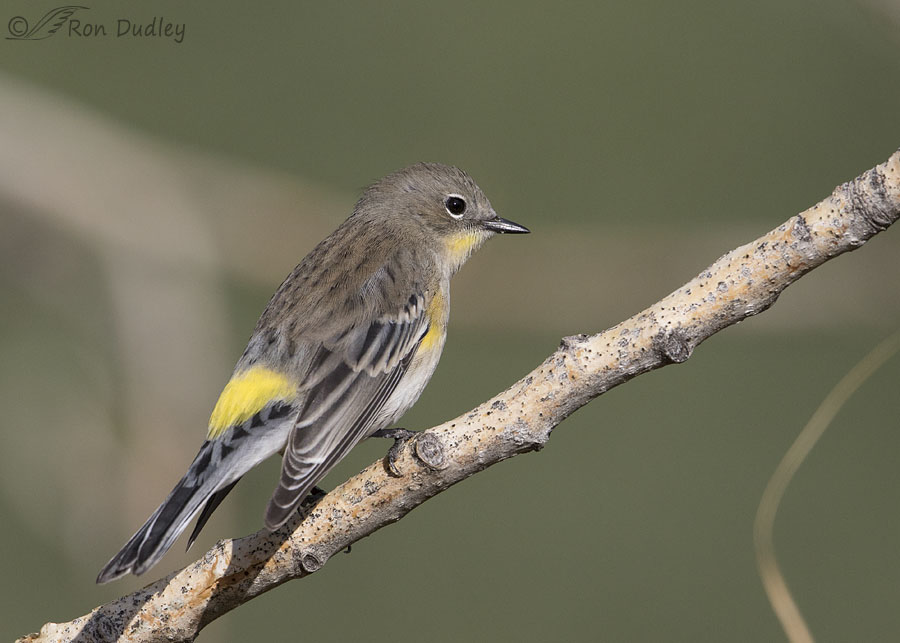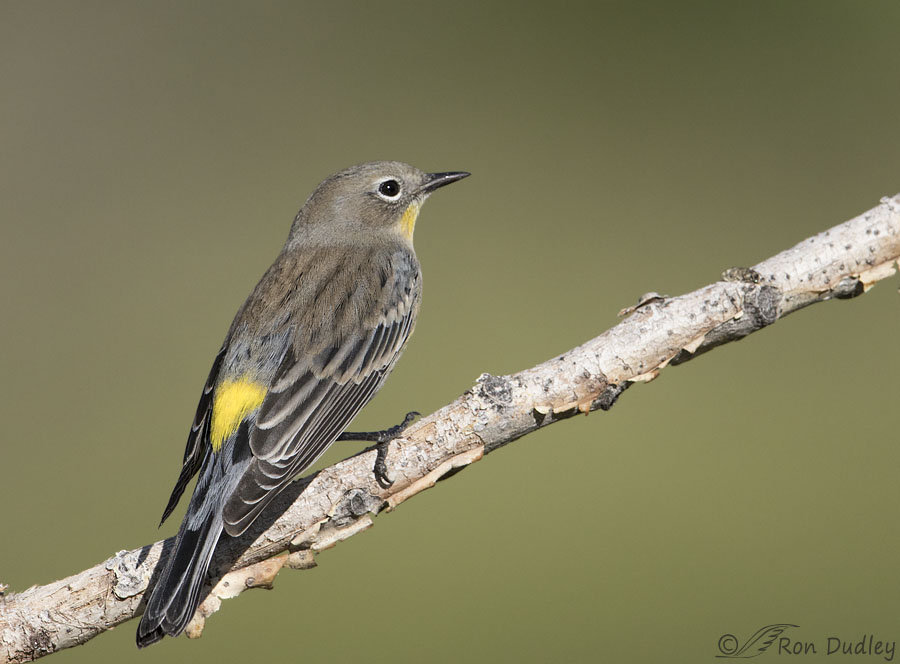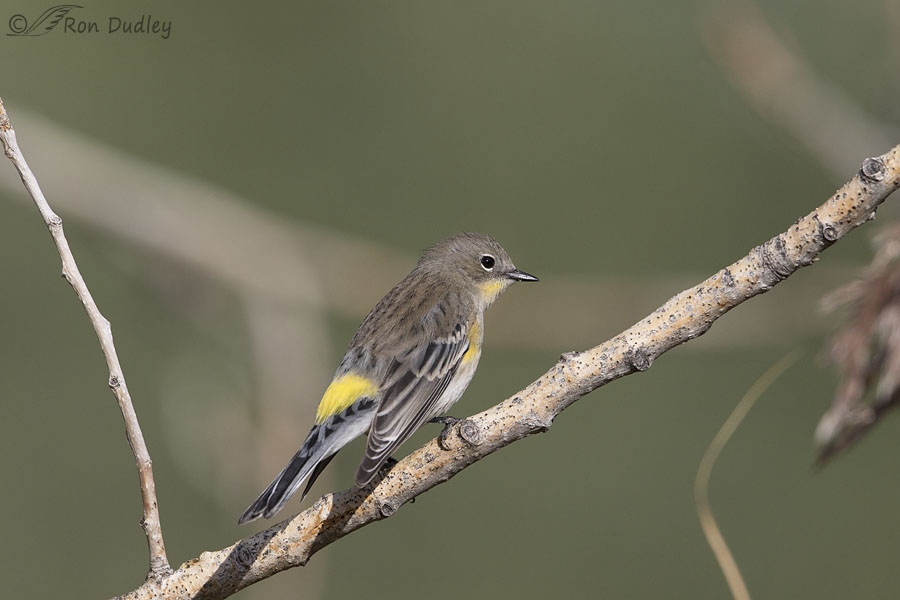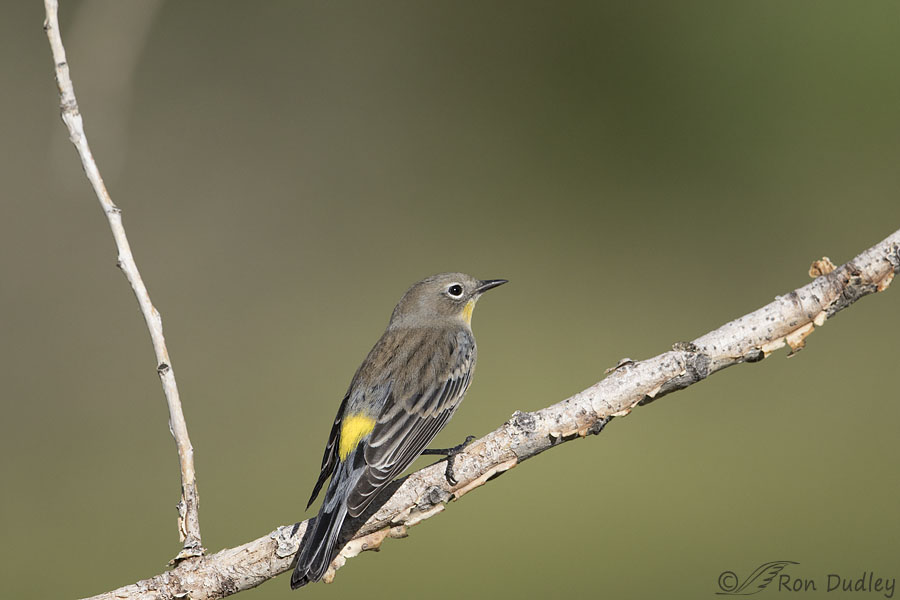I like both of these photos at least in part because the namesake “butter butt” of the species is so very obvious – often it isn’t. But last night on closer inspection something else of interest caught my eye.
Both birds were photographed in the tree I used to call the Kingfisher Tree because for a couple of years I photographed a male and a female kingfisher in it many times and posted the photos here. Sadly it’s been many months since I’ve seen kingfishers there.

1/4000, f/7.1, ISO 640, Canon 7D Mark II, Canon EF 500mm f/4L IS II USM + EF 1.4 III Extender, not baited, set up or called in
The tree is large with many thousands of branches and twigs that typically cause annoying obstructions in front of the bird or distracting elements near or behind them. In this shot the out-of-focus twigs are far enough behind the bird that I don’t find them particularly offensive and I love the way the drooped wing revealed the often hidden yellow rump.
There’s a pond beneath the tree and these warblers were hawking insects flying over the water.

1/4000, f/6.3, ISO 640, Canon 7D Mark II, Canon EF 500mm f/4L IS II USM + EF 1.4 III Extender, not baited, set up or called in
This warbler, a different bird, held its wing higher but the yellow rump is still very apparent. Did you notice anything else the two images have in common besides a Yellow-rumped Warbler on a branch with a greenish background?
Even though the two photos were taken over a year apart (9-24-16 and 9-27-17) and the tree they were perched on had thousands of branches to choose from the two warblers are on the same diagonal branch and in almost the same spot on that branch and I didn’t even notice it until last night. In these versions of the images evidence of that fact is best seen by the three roundish leaf scars on the branch and its overall shape.
But it becomes even more apparent in the full frame (uncropped) versions of the same two photos below.

This is the photo that was taken on September 24, 2016…

and this one was taken on September 27, 2017.
But so what if two warblers of the same species landed on the same perch a year apart, it’s no big deal, right?
Of course it isn’t but for folks like me it adds another layer of interest to the images and it also has a practical application. Besides two beautiful birds in a natural setting with good detail and appealing poses I can and do compare the changes that have and haven’t occurred to the branch and twig over the span of almost exactly one year (that’s probably the biologist in me coming out). I can be a little OCD about such things but the tendency to notice them has served me well over the years as a bird photographer. The advantage to the photographer of predicting favorite perches is obvious and this branch is apparently a great one for hawking. As I often say, “little things matter” and I just never know when a small observational detail like this might come in handy in both my photography and in my blogging.
It might have taken me a year or two to notice it but better late than never. And for me the condition of that branch over a year’s time reinforces the old adage “The more things change the more they remain the same.”
Ron


I think this is SOOOO cool! I love serendipitous events like this. I have a pair of photos taken of the same humpback whale two years apart — the photographer was out shooting on a boat and the whale came close and turned one eye up toward the camera. The whale had an injury and a couple of barnacle scars, so it made the eye very unique. Two years later — same thing — same whale.
Marty, I’m SOOOOOO envious! I’d love to see humpback whales up close and personal…on the bucket list!!
Definitely ditto.
Any whales really.
I’ve gone whale watching a few times — lots of fun! I wish I had been out on the boat when my whale shots were taken; the prints I have are 16×20 and I have them side-by-side.
Laura, it is great to see you posting again! I’ve missed you! 🙂
Neato, Marty. I’ll bet those two prints are wonderful to see together.
Ron: I think the weather-pruned branches behind the perch leads to a nicer photo. Do you?
Actually I don’t, Richard. If they hadn’t been directly behind the bird I would have though.
Very cool observation. I’ve looked through all my books and can’t tell how you are able to differentiate male/female.
Lyle, I didn’t even realize I’d referred to these birds as males until I read your comment. Actually I can’t tell the difference and I shouldn’t have called them males. I’ll edit my text. Thanks for the heads up.
Lyle,
If you have National Geographic Field Guide to Birds of North America, seventh edition, page 472 you will see Yellow-rumped Warbler and the Audubon race. There is a definite difference between male and female. However, I believe this fellow Ron took a picture of is a first year bird. Males, although duller in the fall retain enough of their breeding markings to be called male. First year birds are tough to tell when they look like this one. Hope this helps.
It does help, Dick – thanks!
Hooray for butterbutts on display. Love your eye for detail. And having my own feelings/observations about birds being creatures of habit re-inforced. I do wonder though whether they retain less than desirable habits (as our species so often does). I suspect not, because cause and effect are often so intimately related. Any thoughts?
EC, my bet is that they don’t repeatedly do negative things like humans so often do – for whatever reason. Call it natural selection, innate “smarts” or whatever…
You’re right. Many birds tend to be habitual in the context of what works works. Evidently, several birds have found hunting success from that perch, so it ain’t broke 😉 I know that habitual thing is certainly true with redtails. They have their favorite perches, generally because they can command the greatest amount of real estate in their search for food. In our regular fields, I always knew how Mariah would work it.
HOWEVER, the fact that the butter butts are now using it begs the question, where are the kingfishers?
Laura, the pond below the tree is a mess now and has been for many months. Most of the time it’s either dry or covered with algae and gunk. Not a good place for kingfishers to fish, especially with the river nearby.
Beautiful shots! I actually figured out that it must be the same branch, and also noticed that the birds are basically at the same angle on the branch. It has occurred to me that it might be the same bird in both photos. The reason I say that is that in my experience of feeding birds (in this case specifically Juncos), birds are creatures of habit and come back to the same place every year. I noticed that one year when I had changed the location where I scattered seed, but the Juncos were looking for seed where I used to scatter it. That’s how I knew it was the same group that had been visiting my yard. I still remember where I was when I saw my first “butter butt”. They are beautiful birds.
You sound a little more confident that it might be the same bird than I am, Susan. To me it seems like a long shot since they were over a year apart and they were migrating. But what do I know… 🙂
A touch of yellow on the throat (Eastern Yellow-rumped have white throat) and the fact this bird is in Utah, suggest this could be a Fall Audubon’s Warbler, a western race of the Yellow-rumped. Great images Ron! I think one of the basic characteristics of a “hunter” is noticing behavioral characteristics so that the hunter can anticipate how to capture his/her quarry the next time! Your ability as a photographer captures that trait! Well done!
I’m sure it’s an Audubon’s, Dick and quite certain it’s migrating. Over the next few weeks we should have good numbers of them. Thanks.
Very nice photos Ron. I have often noticed especially with Kestrels that many times over many months that I will be taking the same picture of the same Kestrel on the same perch months or even a year apart. I think that just like we have a favorite chair they have their favorite places to stop.
Everett Sanborn, Prescott AZ
Kestrels are notorious for that behavior, Everett – probably more so than any other species I photograph, including other raptors like red-tails who also do it.
Beautiful shots Ron….:) I was looking for “the ring” on the twig in the 2nd photo a ways in front of the bird – it’s there……. The twig has deteriorated over a year whether “just cuz” or from “bird traffic”. Only reason the rings are noticeable to me is it’s a pruning spot for our apple tree. 😉 I’ve also noticed that some perches are favored year after year for some birds. A huge old cottonwood that finally totally died had to come down the other day since it was in danger of partially falling on the well! 🙁 Many different birds have used that tree for many purposes – really leaves a “gap” where it stood.
Thank you, Judy. Most of this tree is dead now so there won’t be any more growth rings. Typically the parks department would take the dead tree out but I talked to them and I think I’ve convinced them to leave it, at least for now. It isn’t a potential danger to anyone or anything because if it fell over it would just fall into the pond.
The warbler may also be thinking, “Hey, there’s Ron Dudley photographing from a favorite roadside perch again”.
It probably was, Robert. I used to be a regular there every day at the same time whenever there was good light.
Interesting find and observation. I think the probability of catching the same type of bird in the same spot and on nearly the same day is something to be considered also. Then factor in the sex of the bird. I wonder what those odds would be? I find myself studying the branches of trees often in my photos but that’s the horticulturist in me. Looking at these photos the first thing I searched for was a second terminal bud ring to see how much the tree grew over the course of the year…🤔
Thanks, Kathy. I’m no botanist but I guess you’d have to see the end of the branch or twig to find the most recent terminal bud ring…?
Ron, was it the 6.3 vs 7.1 exposure that made the difference in the obviousness of the twigs in the background or is there some other change? The second is lovely without those distractions!
Nancy – It was where I parked my pickup that made the difference you mention (as per usual I was shooting out my window). In the first shot I was parked a few inches to the left of where I was in the second shot. Notice the out of focus vertical twig behind the bird in the first photo next to its yellow rump. The bottom part of that twig can also be seen in the second photo at the upper left hand corner of the frame in the uncropped photo.